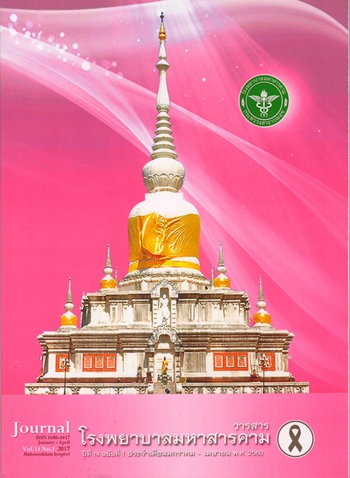การศึกษาผู้ป่วยบาดเจ็บท่อปัสสาวะที่มารับการรักษาที่โรงพยาบาลมหาสารคาม
บทคัดย่อ
ความเป็นมา : การบาดเจ็บท่อปัสสาวะเป็นภาวะที่ ทำให้เกิดภาวะแทรกซ้อน เพิ่มค่าใช้จ่าย และ ระยะเวลานอนรักษาในโรงพยาบาลโดยไม่จำเป็น
วัตถุประสงค์ : เพื่อศึกษาเกี่ยวกับผู้ป่วยบาดเจ็บท่อปัสสาวะ ที่มารับการรักษาที่ โรงพยาบาลมหาสารคาม โดยข้อมูลที่ได้จะนำมาวิเคราะห์เพื่อที่จะเป็นประโยชน์ในการดูแลรักษาผู้ป่วยให้มีประสิทธิภาพยิ่งขึ้น
รูปแบบและวิธีการวิจัย : การศึกษานี้เป็นแบบการวิจัยเชิงพรรณาแบบย้อนหลังโดยมีผู้ป่วยบาดเจ็บท่อปัสสาวะจำนวน51 คน ที่มารับการรักษาที่โรงพยาบาลมหาสารคาม ระหว่าง เดือน มกราคม 2554 ถึง เดือน มิถุนายน 2559 โดยเก็บรวบรวมข้อมูล อาทิเช่น ข้อมูลทั่วไป ข้อมูลเกี่ยวกับสาเหตุ ข้อมูลการรักษาเบื้องต้น ข้อมูลภาวะแทรกซ้อน แล้วนำข้อมูลที่ได้มาวิเคราะห์ทางสถิติ
ผลการศึกษา : การบาดเจ็บท่อปัสสาวะในโรงพยาบาลมหาสารคามทั้งหมดเป็นเพศชาย โดยที่พบ การบาดเจ็บท่อปัสสาวะสาเหตุจากการใส่สายสวนปัสสาวะมากที่สุดเมื่อเทียบกับสาเหตุอื่น (66.66%) การบาดเจ็บท่อปัสสาวะสาเหตุจากการใส่สายสวนปัสสาวะพบได้บ่อยในผู้ป่วยอายุ 60 ปีขึ้นไป (73.52 %) ร่วมกับมีภาวะต่อมลูกหมากโต (35.29%) และ การรักษาเบื้องต้นส่วนมากคือการใส่สายสวนปัสสาวะ (41.17%) พบว่า มีผู้ป่วยที่มีภาวะแทรกซ้อนที่เกิดขึ้นรุนแรง 1 ราย
สรุป : ในโรงพยาบาลมหาสารคามมีการบาดเจ็บท่อปัสสาวะสาเหตุจากการใส่สายสวนปัสสาวะมากกว่าสาเหตุอื่น จึงควรมีการทบทวนเกี่ยวกับการใส่สายสวนปัสสาวะ และ มีแนวทางการป้องกันและ ลดอุบัติการณ์ที่จะเกิดขึ้นในโอกาสต่อไป
คำสำคัญ : การบาดเจ็บท่อปัสสาวะ การใส่สายสวนปัสสาวะ
เอกสารอ้างอิง
Chapple CR, Png D. Contemporary management of urethral trauma and the post-traumatic stricture. CurrOpinUrol 1999;9:253-60.
Sevitt S. Fatal road accidents. Injuries, complications, and causes of death in 250 subjects. Br J Surg 1968; 55:481-505.
NicolaisenGS,Melamud A, Williams RD, McAninch JW. Rupture of the corpus cavernosum: surgical management. J Urol 1983; 130:917-9.
Pontes JE, Pierce Jr JM. Anterior urethral injuries: four years of experience at the Detroit General Hospital. J Urol 1978; 120:563-4.
Gomez RG, Ceballos L, Coburn M, et al. Consensus statement on bladder injuries. BJU Int 2004; 94:27-32.
Figler BD, Hoffler CE, Reisman W, et al. Multi-disciplinary update on pelvic fracture associated bladder and urethral injuries. Injury 2012; 43:1242-9.
Bjurlin MA, Fantus RJ, Mellett MM, Goble SM. Genitourinary injuries in pelvic fracture morbidity and mortality using the National Trauma Data Bank. J Trauma 2009; 67:1033-9.
Brandes S. Initial management of anterior and posterior urethral injuries. UrolClin North Am 2006; 33:87-95.
Brandes S. Initial management of anterior and posterior urethral injuries. UrolClin North Am 2006; 33:87-95.
Rosenstein DI, Alsikafi NF. Diagnosis and classification of urethral injuries. UrolClin North Am 2006; 33:73-85.
Cinman NM, McAninch JW, Porten SP, et al. Gunshot wounds to the lower urinary tract: a single-institution experience. J Trauma Acute Care Surg 2013; 74:725-30.
Quagliano PV, Delair SM, Malhotra AK. Diagnosis of blunt bladder injury: a prospective comparative study of computed tomography cystography and conventional retrograde cystography. J Trauma 2006; 61:410-21.
Ramchandani P, Buckler PM. Imaging of genitourinary trauma. Am J Roentgenol 2009; 192:1514-23.
Shenfeld OZ, Gnessin E. Management of urogenital trauma: state of the art. CurrOpinUrol 2011; 21:449-54.
Chapple C, Barbagli G, Jordan G, et al. Consensus statement on urethral trauma. BJU Int 2004; 93:1195-202.
Manalo M, Lapitan MC and Buckley BS: Medical interns’ knowledge and training regarding urethral catheter insertion and insertion-related urethral injury in male patients. BMC Med Educ 2011; 11: 73.
Kashefi C, Messer K, Barden R et al: Incidence and prevention of iatrogenic urethral injuries. J Urol 2008; 179: 2254.
Thomas AZ, Giri SK, Meagher D et al: Avoidable iatrogenic complications of urethral catheterization and inadequate intern training in a tertiary-careteaching hospital. BJU Int 2009; 104: 1109.
ดาวน์โหลด
เผยแพร่แล้ว
รูปแบบการอ้างอิง
ฉบับ
ประเภทบทความ
สัญญาอนุญาต
วารสารนี้เป็นลิขสิทธิ์ของโรงพยาบาลมหาสารคาม






